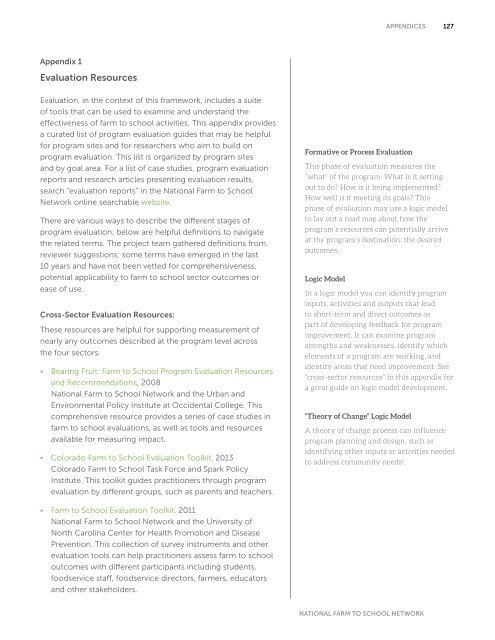Framework-08-25-14_web
Framework-08-25-14_web
Framework-08-25-14_web
You also want an ePaper? Increase the reach of your titles
YUMPU automatically turns print PDFs into web optimized ePapers that Google loves.
APPENDICES127Appendix 1Evaluation ResourcesEvaluation, in the context of this framework, includes a suiteof tools that can be used to examine and understand theeffectiveness of farm to school activities. This appendix providesa curated list of program evaluation guides that may be helpfulfor program sites and for researchers who aim to build onprogram evaluation. This list is organized by program sitesand by goal area. For a list of case studies, program evaluationreports and research articles presenting evaluation results,search “evaluation reports” in the National Farm to SchoolNetwork online searchable <strong>web</strong>site.There are various ways to describe the different stages ofprogram evaluation; below are helpful definitions to navigatethe related terms. The project team gathered definitions fromreviewer suggestions; some terms have emerged in the last10 years and have not been vetted for comprehensiveness,potential applicability to farm to school sector outcomes orease of use.Cross-Sector Evaluation Resources:These resources are helpful for supporting measurement ofnearly any outcomes described at the program level acrossthe four sectors.• Bearing Fruit: Farm to School Program Evaluation Resourcesand Recommendations, 20<strong>08</strong>National Farm to School Network and the Urban andEnvironmental Policy Institute at Occidental College. Thiscomprehensive resource provides a series of case studies infarm to school evaluations, as well as tools and resourcesavailable for measuring impact.• Colorado Farm to School Evaluation Toolkit, 2013Colorado Farm to School Task Force and Spark PolicyInstitute. This toolkit guides practitioners through programevaluation by different groups, such as parents and teachers.Formative or Process EvaluationThis phase of evaluation measures the“what” of the program: What is it settingout to do? How is it being implemented?How well is it meeting its goals? Thisphase of evaluation may use a logic modelto lay out a road map about how theprogram’s resources can potentially arriveat the program’s destination: the desiredoutcomes.Logic ModelIn a logic model you can identify programinputs, activities and outputs that leadto short-term and direct outcomes aspart of developing feedback for programimprovement. It can examine programstrengths and weaknesses, identify whichelements of a program are working, andidentify areas that need improvement. See“cross-sector resources” in this appendix fora great guide on logic model development.“Theory of Change” Logic ModelA theory of change process can influenceprogram planning and design, such asidentifying other inputs or activities neededto address community needs 1 .• Farm to School Evaluation Toolkit, 2011National Farm to School Network and the University ofNorth Carolina Center for Health Promotion and DiseasePrevention. This collection of survey instruments and otherevaluation tools can help practitioners assess farm to schooloutcomes with different participants including students,foodservice staff, foodservice directors, farmers, educatorsand other stakeholders.NATIONAL FARM TO SCHOOL NETWORK


